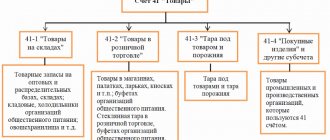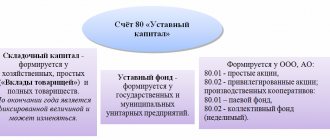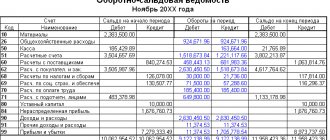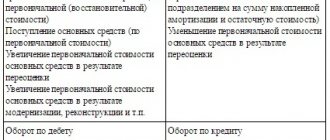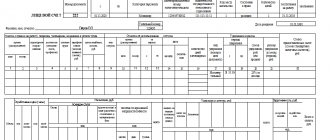Sales of goods, works, services
Work on selling products in an organization begins with concluding an agreement with the buyer; the agreement can sometimes be an invoice for payment. Once the intent to purchase has been secured by contract, the buyer is usually issued an invoice. The invoice indicates the seller’s details, including bank details, the amount of payment, taxes (VAT, excise taxes) included in the cost of goods (work, services).
The invoice is issued by an authorized person, usually a manager or accountant, in 2 copies: one for the buyer, the second for the accounting department. Signed by the manager and chief accountant. Own copies are filed in chronological order, copies of the buyer are sent to him.
Settlements with buyers and customers are carried out on account 62 “Settlements with buyers and customers”. Revenue is reflected in subaccount 90.1 “Revenue”.
Goods, finished products
To ship goods and products, a consignment note TORG-12 and transferred to the warehouse to the warehouseman. releases goods based on a power of attorney
If the organization has shipped products or goods and ownership has passed to the buyer, then the fact of sale is reflected in the accounting records with the following entry:
Debit 62 Credit 90.1 - revenue from the sale of products (goods) is reflected. Revenue is reflected together with VAT.
At the same time, it is necessary to reflect the write-off of the cost of goods (products) in the debit of subaccount 90-2 “Cost of sales”, income from the sale of which is recorded in subaccount 90.1.
Debit 90.2 Credit 41 (43,45,20...) - the cost of goods sold is written off.
The organization must charge VAT simultaneously with the sale. She must issue an invoice within five calendar days from the date of shipment of the goods.
Debit 90.3 Credit 68 “Calculations for VAT” - VAT has been charged.
Accounting for revenue from the sale of finished products: transactions and taxes
Sales of finished products are one of the most common business transactions that an accountant needs to reflect in accounting. On the one hand, there is a lot of legislative and explanatory information, on the other hand, there are various situations when standard accounting methods are not suitable.
Correct accounting of revenue from the sale of finished products is also extremely important because it affects the amount of accrued VAT and income tax, as well as the indicators of the organization’s financial and economic activities.
The content of the article:
1. Why is it important to carefully study the contract with the buyer?
2. What documents are needed to sell products
3. Accounting accounts for accounting for sales of finished products
4. Postings when selling finished products, transfer of rights - at the time of shipment
5. Postings when selling with a deferred transfer of ownership
6. Tax accounting of revenue from sales of finished products
7. Accounting for revenue from the sale of finished products using an example
8. Sales of finished products in 1C version 8.3
So, let's go in order.
Why is it important to carefully study the contract with the buyer?
Sales of products are carried out under contracts with different conditions, invoices, offers, letters and applications. And it is the content of these documents that most influences the choice of a scheme for accounting for revenue from the sale of finished products in a particular situation.
In contracts, first of all, you need to look at the clauses that regulate the moment of transfer of ownership of the product from the seller to the buyer. The date of reflection of revenue in accounting depends on this
Transfer of ownership can be:
- deferred _ It is tied to a specific event, for example, the buyer receiving products at his warehouse. Such points must be specified in the contract or invoice offer.
- on the day of sale . Such a condition may also be specified in the contract. It is also considered that ownership is transferred immediately if the products are shipped upon application (letter) or for cash (non-cash) payment to private individuals.
What documents are needed to sell products?
Instead of the product, the buyer is given a set of documents:
- consignment note (according to TORG-12 form)
- invoice (not always)
- a delivery note and an invoice can be replaced by an UTD ─ a universal transfer document
- documents required for transportation of products
- other documents specified in the contract
To account for the sale of products, an accountant needs the first two in the list or UPD. It is better to check with the organization that deals with cargo transportation what documents are needed for a transport company.
A consignment note is usually drawn up using the TORG-12 form, approved by Decree of the State Statistics Committee of the Russian Federation dated December 25, 1998 No. 132. Although the use of unified forms is currently not necessary, many organizations continue to use just such documents.
The delivery note must be drawn up in at least 2 copies: one for the seller, the other for the buyer. In the case where the contract provides for a deferred transfer of ownership ─ at the time of receipt of the product at the buyer’s warehouse ─ it is more convenient to make three copies. The first one, only with the signature “Cargo released”, is needed to write off the products to account 45, it remains with the seller. Two copies are sent to the buyer. After accepting the products, the buyer signs both copies of TORG-12, in the column “The cargo was received by the consignee”, and puts the date. One signed document is sent to the seller to reflect the proceeds.
An invoice is drawn up only if the selling organization is a VAT payer. Those who work for the simplified tax system do not issue invoices. But this document may not be available to an organization that works for a special purpose tax system if operations for the sale of products fall under the benefits provided for in Article 149 of the Tax Code of the Russian Federation. Usually the invoice is issued in two copies.
UPD is a document in which a delivery note is combined with an invoice. The UPD form was recommended by letter of the Federal Tax Service of Russia dated October 21, 2013 No. ММВ-20-3/ [email protected]
Accounting accounts for accounting for sales of finished products
To account for the sale of finished products, the following accounting accounts are mainly used:
90.1 ─ “Revenue”
90.2 ─ “Cost of sales”
90.3 ─ “VAT”
90.4 ─ “Excise taxes”
90.9 ─ “Profit/loss from sales”
62 ─ “Settlements with buyers and customers”
76 ─ “Settlements with various debtors and creditors” for calculating VAT in case of deferred transfer of ownership and prepayment
68 ─ “Calculations for taxes and fees”
43 ─ “Finished products”
45 ─ “Goods shipped”
51 ─ “Current account”
When products are sold by employees of the organization, accounts receivable are formed on account 73 “Settlements with personnel for other operations.” If customers pay for products in cash, the payment is reflected in account 50 “Cashier”.
Postings for the sale of finished products, transfer of rights - at the time of shipment
When choosing a posting scheme to account for the sale of finished products, you need to understand three points:
- transfer of ownership
- terms of payment
- which comes first ─ shipment or payment
This is important to know in order to timely charge VAT to the budget. According to Art. 167 Tax Code, VAT must be charged on the day of payment if payment was made before shipment, or vice versa. We spoke in great detail about the formation of the tax base for VAT in this article, we recommend that you also read it. You will also find this article useful, where we discussed in detail the calculation of VAT on an advance received from the buyer.
Let's consider a transaction diagram where the transfer of ownership occurs at the time of shipment, and payment is received after receipt of the product .
| Wiring | Business transaction | Document |
| Dt 90.2 ─ Kt 43 | Products shipped from the seller's warehouse | Consignment note with the signature of the materially responsible person in the column “Cargo released” |
| Dt 62.01 ─ Kt 90.1 | The buyer's receivables have been generated | Invoice |
| Dt 90.3 ─ Kt 68 | VAT accrued for payment | Invoice |
| Dt 51 ─ Kt 62.01 | Payment received for finished products | Bank statement |
Let's consider a transaction diagram where the transfer of ownership occurs at the time of shipment, the payment procedure is prepayment .
| Wiring | Business transaction | Document |
| Dt 51 ─ Kt 62.02 | Received advance payment for products | Bank statement |
| Dt 76.AV ─ Kt 68 | VAT is charged on the prepayment amount | Bank statement, invoice for advance payment |
| Dt 90.2 ─ Kt 43 | Products shipped from the seller's warehouse | Consignment note with the signature of the materially responsible person in the column “Cargo released” |
| Dt 62.01 ─ Kt 90.1 | The buyer's receivables have been generated | Product invoice |
| Dt 90.3 ─ Kt 76.AV | VAT charged on products sold | Product invoice |
| Dt 62.02 ─ Kt 62.01 | Offset of prepayment | Accounting information |
Postings when selling with deferred transfer of ownership
Postpaid wiring diagrams :
| Wiring | Business transaction | Document |
| Dt 45 ─ Kt 43 | Products shipped from the seller's warehouse | Consignment note with the signature of the materially responsible person in the column “Cargo released” |
| Dt 76.OT ─ Kt 68 | VAT charged on products sold | Invoice by date of shipment for VAT calculation |
| Dt 62.01 ─ Kt 90.1 | The buyer's receivables have been generated | A document that confirms the transfer of ownership (for example, TORG-12 with the signature of the buyer) |
| Dt 90.2 ─ Kt 45 | The cost of shipped products is written off | A document that confirms the transfer of ownership |
| Dt 90.3 ─ Kt 76.OT | VAT charged on products sold | Product invoice |
| Dt 51 ─ Kt 62.01 | Payment received for finished products | Bank statement |
Prepayment wiring diagrams :
| Wiring | Business transaction | Document |
| Dt 51 ─ Kt 62.02 | Received advance payment for products | Bank statement |
| Dt 76.AV ─ Kt 68 | VAT is charged on the prepayment amount | Bank statement, invoice for advance payment |
| Dt 45 ─ Kt 43 | Products shipped from the seller's warehouse | Consignment note with the signature of the materially responsible person in the column “Cargo released” |
| Dt 62.01 ─ Kt 90.1 | The buyer's receivables have been generated | A document that confirms the transfer of ownership |
| Dt 90.3 ─ Kt 76.AV | VAT charged on products sold | Product invoice |
| Dt 90.2 ─ Kt 45 | The cost of shipped products is written off | A document that confirms the transfer of ownership |
| Dt 62.02 ─ Kt 62.01 | Offset of prepayment | Accounting information |
62.01 – settlements with customers for sold products
62.02 – advances received from buyers
76.AB – VAT on advances and prepayments
76.OT – VAT accrued on shipment
Profit (loss) from the sale of products is determined monthly on account 90, taking into account the turnover in all sub-accounts. The financial result is written off to account 99 “Profits and losses” in correspondence with account 90.9. Account 90 should not have a balance at the end of the month.
For organizations that use the simplified tax system, entries for calculating VAT must be excluded from the given schemes for accounting for transactions for the sale of finished products.
Tax accounting of revenue from sales of finished products
In tax accounting, it is important to determine whether the revenue received from the sale of products relates to the income of this tax period. This determines how correctly the amount of income will be determined, which affects the amount of income tax. Moreover, this is important both for organizations that use the simplified tax system and for those who work on the simplified tax system (6% and 15%).
In tax accounting, there are two methods for determining income from the sale of finished products:
- cash method
- accrual method
The cash method is used by organizations that use the simplified tax system (Article 346.17 of the Tax Code of the Russian Federation). It is allowed to calculate income using this method and those of the taxpayer on the OSN that fall under clause 1 of Art. 273 Tax Code of the Russian Federation.
With the cash method, the day on which payment is received is important. It could be:
- the day the money is received in the bank account or cash register
- the day of receipt of goods that were received as payment
- the day of signing the certificate of completion of work (services) that were provided as payment for products
It does not matter whether payment was received before the products were shipped or after.
If the prepayment was made in one tax period, and the shipment is planned in the next, then the income should be taken into account exactly in the period when the money was received.
Conversely, shipment of products during the reporting tax period does not mean receipt of income if there has been no payment.
The accrual method is used by the vast majority of organizations on OSN. In this case, income recognition is tied to the moment of transfer of ownership of the product (clause 3 of Article 271 and clause 1 of Article 39 of the Tax Code of the Russian Federation). And it has nothing to do with receipt of payment.
If the products were shipped in one tax period, and the transfer of ownership occurs only in another, then the income does not need to be reflected in tax accounting.
For the timely generation of income within the framework of tax accounting, organizations on the OSN need to track the dates of reflection of revenue on the credit of account 90.1. And those who work for the simplified tax system need to look at the dates of receipt of payment in the debit of cash accounting accounts. The topic of selling goods on the simplified tax system will be discussed in more detail in another article.
Accounting for revenue from the sale of finished products using an example
Let's consider two organizations: one works on the OSN, the other on the simplified tax system.
The conditions are the same:
- prepayment for products in December 2020
- transfer of ownership ─ at the time of shipment, in January 2018
- product cost 300,000 rubles excluding VAT, 354,000 rubles including VAT
- production cost ─ 250,000 rubles
| OSN | simplified tax system |
| Accounting _ | |
| Receipt of prepayment (December 2017) | |
| Dt 51 ─ Kt 62.02 354,000 rubles | Dt 51 ─ Kt 62.02 300,000 rubles |
| VAT charged on payment (December 2017) | |
| Dt 76.AV ─ Kt 68 54,000 rubles | ─ |
| Products shipped (January 2018) | |
| Dt 90.2 ─ Kt 43,250,000 rubles | Dt 90.2 ─ Kt 43,250,000 rubles |
| Accounts receivable generated (January 2018) | |
| Dt 62.01 ─ Kt 90.1 354,000 rubles | Dt 62.01 ─ Kt 90.1 300,000 rubles |
| VAT accrued for products sold (January 2018) | |
| Dt 90.3 ─ Kt 76.AV 54,000 rubles | ─ |
| Offset of prepayment towards debt repayment (January 2018) | |
| Dt 62.02 ─ Kt 62.01 354,000 rubles | Dt 62.02 ─ Kt 62.01 300,000 rubles |
| Profit from product sales | |
| Dt 90.9 ─ Kt 99 50,000 rubles | Dt 90.9 ─ Kt 99 50,000 rubles |
| Accrual of income in tax accounting | |
| 300,000 rubles in January 2018 | 300,000 rubles in December 2017 |
62.01 – settlements with customers for sold products
62.02 – advances received from buyers
76.AB – VAT on advances and prepayments
The example shows the difference between accounting and tax accounting of revenue from the sale of finished products in organizations that are on different taxation systems.
Retail sales have their own characteristics both in terms of transactions and paperwork; in this topic, the article at this link will help you.
Sales of finished products in 1C version 8.3
In order to correctly reflect the operations for selling finished products in 1C version 8.3, watch the video.
In any, even the most non-standard situation that is associated with the sale of finished products, you can find reference points: the date of transfer of ownership and the date of payment. Taking into account this information and the tax system on which the organization operates, you can always correctly set up accounting for revenue from the sale of finished products.
Please ask any questions on this topic in the comments to the article.
Accounting for revenue from the sale of finished products: transactions and taxes
Agreement with a special transfer of ownership
If the contract specifies that ownership of the goods will be transferred not after shipment, as is considered by default, but, for example, after payment, such an agreement is considered an agreement with a special transfer of ownership. Shipped goods must be accounted for on account 45 “Goods shipped”.
Debit 45 Credit 41 - goods (GP) were shipped under an agreement with a special transfer of ownership.
Even though title has not passed to the buyer, VAT must be charged on the day of shipment.
Debit 76 “Calculations for VAT on advances received” Credit 68 - VAT accrued on goods shipped.
Debit 51 Credit 62 - the buyer’s payment is reflected.
Debit 62 Credit 90.1 - revenue is reflected.
Debit 60.2 Credit 45 - the cost of shipped goods is written off.
Debit 90.3 Credit 68 - VAT charged
Debit 68 Credit 76 “Calculations for VAT on advances received” - VAT accrued on shipments has been restored.
How to account for sales of goods
The accounting record of sold inventory items is made at the time of shipment of goods. Accounting procedures for the sale of goods are as follows:
| Debit | Credit | Description |
| 62 | 90.1 | Revenue received from product sales |
| 90.2 | 41 | Write-off of the cost of goods sold |
| 90.5 | 44 | Write-off of costs associated with the sale |
| 51 | 62 | Receiving payment from the customer |
If, under the terms of the agreement, the transfer of ownership of sold goods and materials from the seller to the buyer is carried out at the time of payment, then, on the basis of clause 12 of PBU 9/99 (subclause “d”), revenue is not recognized at the time of delivery of the goods. When reflecting shipment and sale transactions, invoices are used. 45. Accounting entries for the sale of goods and services will be as follows:
| Posts | Transaction data |
| Dt 45 Kt 41 | Shipment of goods and materials to the customer |
| Dt 76 Kt 68 | VAT calculation |
| Dt 51 Kt 62 | Receipt of payment to the seller |
| Dt 62 Kt 90.1 | Revenue recognition |
| Dt 90.2 Kt 45 | Write-off of cost of goods and materials |
| Dt 90.3 Kt 76 | VAT credit accrued upon shipment |
| Dt 90.5 Kt 44 | Write-off of sales costs |
Services, works
If an organization has provided services or performed work, then this fact is documented in an act in a free form; there is no standard form, for example, an act of provision of services or an act of completed work. You also need to issue an invoice .
Postings for the provision of services and performance of work are the same as for the sale of goods and finished products:
Debit 62 Credit 90.1 - revenue accrued for services rendered.
Debit 90.2 Credit 20, 26 - the cost of services provided and work performed is written off.
Debit 90.3 Credit 68 - VAT charged.
Reflection of revenue in accounting
Revenue is the amount of money due to the organization from counterparties for products sold, goods, work performed or services provided (clause 5 of PBU 9/99).
Amounts of revenue that bring profit to the organization, regardless of the type of economic activity, are taken into account in account 90 “Sales”.
Account 90 “Sales” collects all information about the organization’s income and expenses, which is accompanied by the production and sales process. Account 90 in accounting is active-passive, therefore, credit turnover reflects the total amount of income, and debit turnover reflects the total amount of expenses.
Account 90 reflects revenue accounting entries for the following types:
- Sales of finished products, goods, semi-finished products of own production;
- Performance of work and provision of services;
- Sales of purchased goods;
- Providing for a fee the temporary use of your property (lease agreement), etc.

